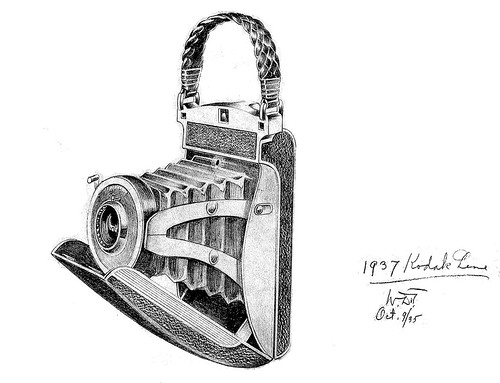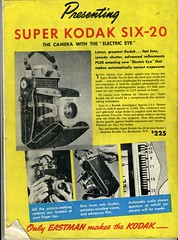Difference between revisions of "Kodak Super Six-20"
m (→Postscript) |
(ad image added) |
||
| Line 13: | Line 13: | ||
The folding clam-shell design was by [[Joe Mihalyi|Joseph Mihalyi]] and styled by [[Walter Dorwin Teague]]. This incorporated crank [[film advance|winding]] and a [[coupled rangefinder]]<ref name="CoeK">Coe, Brian, ''Kodak Cameras, the First Hundred Years'', Hove Foto Books, 1988</ref>. | The folding clam-shell design was by [[Joe Mihalyi|Joseph Mihalyi]] and styled by [[Walter Dorwin Teague]]. This incorporated crank [[film advance|winding]] and a [[coupled rangefinder]]<ref name="CoeK">Coe, Brian, ''Kodak Cameras, the First Hundred Years'', Hove Foto Books, 1988</ref>. | ||
| − | The Super Six-20 was not a great success due to its high price - $225 USD<ref>[http://www.kodak.com/global/en/consumer/products/techInfo/aa13/aa13pg2.shtml Kodak's History of Kodak Cameras]</ref> (app. $3,200 USD in 2007), much more than a contemporary [[Leica]] - and a reputation for unreliability. Kodak employees had nicknamed it "the boomerang" for its regular returns for service<ref name="CoeK" />. | + | The Super Six-20 was not a great success due to its enormously high price - $225 USD<ref>[http://www.kodak.com/global/en/consumer/products/techInfo/aa13/aa13pg2.shtml Kodak's History of Kodak Cameras]</ref> (app. $3,200 USD in 2007), much more than a contemporary [[Leica]] - and a reputation for unreliability. Kodak employees had nicknamed it "the boomerang" for its regular returns for service<ref name="CoeK" />. |
It was withdrawn in 1944; production estimates vary between 714 and 725 being made; 719 is the most common guess. | It was withdrawn in 1944; production estimates vary between 714 and 725 being made; 719 is the most common guess. | ||
{{br}} | {{br}} | ||
| Line 45: | Line 45: | ||
* [http://www.phsc.ca/Show_Tell_2001/Text_Files/Bill_Kantymir.html Bill Kantymir's Super Six-20 story] | * [http://www.phsc.ca/Show_Tell_2001/Text_Files/Bill_Kantymir.html Bill Kantymir's Super Six-20 story] | ||
* [http://www.google.com/patents?id=ottLAAAAEBAJ&dq=camera+inassignee:kodak&as_drrb_ap=b&as_minm_ap=1&as_miny_ap=1935&as_maxm_ap=9&as_maxy_ap=1937&as_drrb_is=q&as_minm_is=0&as_miny_is=&as_maxm_is=0&as_maxy_is=&num=30 Design Patent 2333807] by [[Joe Mihalyi|Joseph Mihalyi]] filed in 1936, granted 1943 {shown on Google Patents} | * [http://www.google.com/patents?id=ottLAAAAEBAJ&dq=camera+inassignee:kodak&as_drrb_ap=b&as_minm_ap=1&as_miny_ap=1935&as_maxm_ap=9&as_maxy_ap=1937&as_drrb_is=q&as_minm_is=0&as_miny_is=&as_maxm_is=0&as_maxy_is=&num=30 Design Patent 2333807] by [[Joe Mihalyi|Joseph Mihalyi]] filed in 1936, granted 1943 {shown on Google Patents} | ||
| + | |||
| + | {{Flickr_image | ||
| + | |image_source= http://www.flickr.com/photos/nesster/4340578290/in/pool-camerapedia/ | ||
| + | |image= http://farm5.static.flickr.com/4013/4340578290_6c43f09268_m.jpg | ||
| + | |image_align= left | ||
| + | |image_text= 1938 ad for "THE CAMERA WITH<br />THE ELECTRIC EYE", showing the $225 price<br /><small>photo by Nesster</small> | ||
| + | }} | ||
== Postscript == | == Postscript == | ||
A auto-exposure patent pre-dates the release of this camera; | A auto-exposure patent pre-dates the release of this camera; | ||
| − | [http://www.google.com/patents?id=CnA_AAAAEBAJ&printsec=abstract&zoom=4&dq=2058562#PPA26,M1 US Patent 2,058,562 ] was granted in 1935 to Gustav Bucky and Albert Einstein! This covers a different, possibly impractical system using neutral-density filters to control light. | + | [http://www.google.com/patents?id=CnA_AAAAEBAJ&printsec=abstract&zoom=4&dq=2058562#PPA26,M1 US Patent 2,058,562 ] was granted in 1935 to Gustav Bucky and Albert Einstein! This covers a different, possibly impractical system using neutral-density filters to control light. The Super Six-20 remains the first auto-exposure camera to go on sale. |
In spite of the commercial failure of the Super Six-20, the "trap-needle" (Electric-Eye, "EE") system of auto-exposure eventually became popular from the late 1950s, until it was replaced by electronic systems in the 1970s. | In spite of the commercial failure of the Super Six-20, the "trap-needle" (Electric-Eye, "EE") system of auto-exposure eventually became popular from the late 1950s, until it was replaced by electronic systems in the 1970s. | ||
| + | |||
Revision as of 02:38, 10 February 2010

|
| Kodak Super Six-20 |
The Kodak Super Six-20 is accepted as being the first camera with automatic exposure, introduced by Kodak in 1938.
Description
Exposure was controlled by a mechanical linkage from a selenium light meter to the aperture control. Pressing the shutter release first locked the meter needle, and moved a lever controlling the aperture up to the needle, before firing the shutter. Adjusting the speed control moved a cover over more or less of the photocell[1].
The folding clam-shell design was by Joseph Mihalyi and styled by Walter Dorwin Teague. This incorporated crank winding and a coupled rangefinder[2].
The Super Six-20 was not a great success due to its enormously high price - $225 USD[3] (app. $3,200 USD in 2007), much more than a contemporary Leica - and a reputation for unreliability. Kodak employees had nicknamed it "the boomerang" for its regular returns for service[2].
It was withdrawn in 1944; production estimates vary between 714 and 725 being made; 719 is the most common guess.

|
| 1936 Patent drawings |
Specification
- Manufacturer: Kodak
- Country of Origin: USA
- Introduced: August 1938[2]
- Withdrawn: August 1944
- Lens: Kodak Anastigmat Special 100mm f/3.5, focus 4ft-infinity
- Shutter: Compur, 8 speeds up to 1/200; shutter priority auto from 1/25-1/200, slower speeds available manually
- Film: 620, frame size 2¼ x 3¼ inches, 6x9cm

|
| 1937 Concept drawings by Walter Dorwin Teague |
Sources
Links
- Super Six-20 on George Eastman House site
- Super Six-20 at the National Media Museum, Bradford, UK
- Bill Kantymir's Super Six-20 story
- Design Patent 2333807 by Joseph Mihalyi filed in 1936, granted 1943 {shown on Google Patents}

|
| 1938 ad for "THE CAMERA WITH THE ELECTRIC EYE", showing the $225 price photo by Nesster |
Postscript
A auto-exposure patent pre-dates the release of this camera; US Patent 2,058,562 was granted in 1935 to Gustav Bucky and Albert Einstein! This covers a different, possibly impractical system using neutral-density filters to control light. The Super Six-20 remains the first auto-exposure camera to go on sale.
In spite of the commercial failure of the Super Six-20, the "trap-needle" (Electric-Eye, "EE") system of auto-exposure eventually became popular from the late 1950s, until it was replaced by electronic systems in the 1970s.